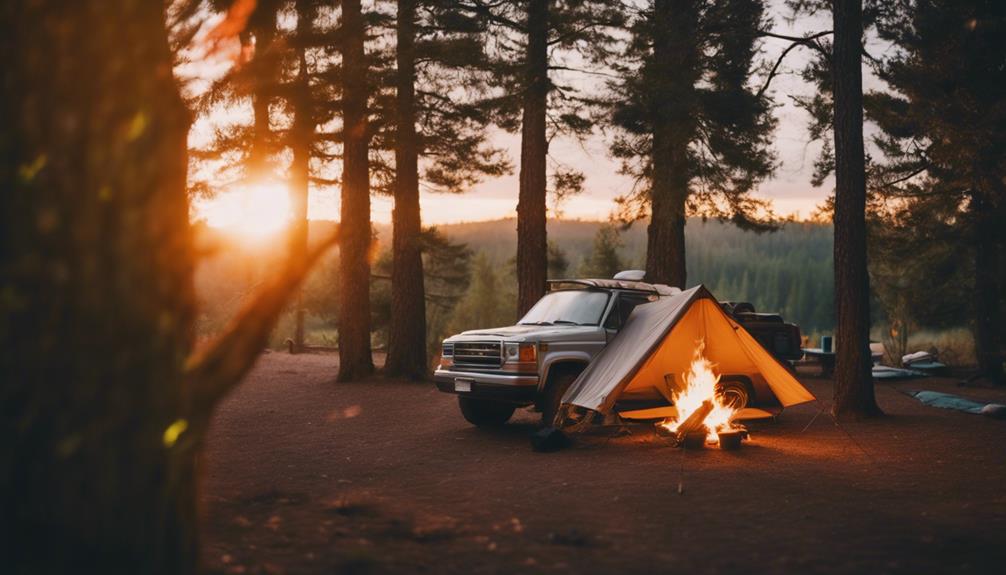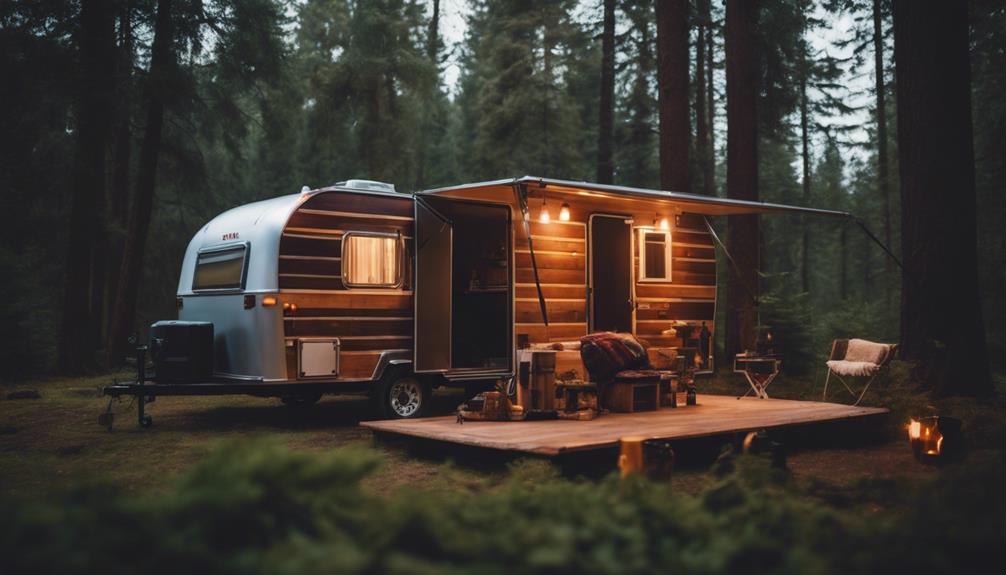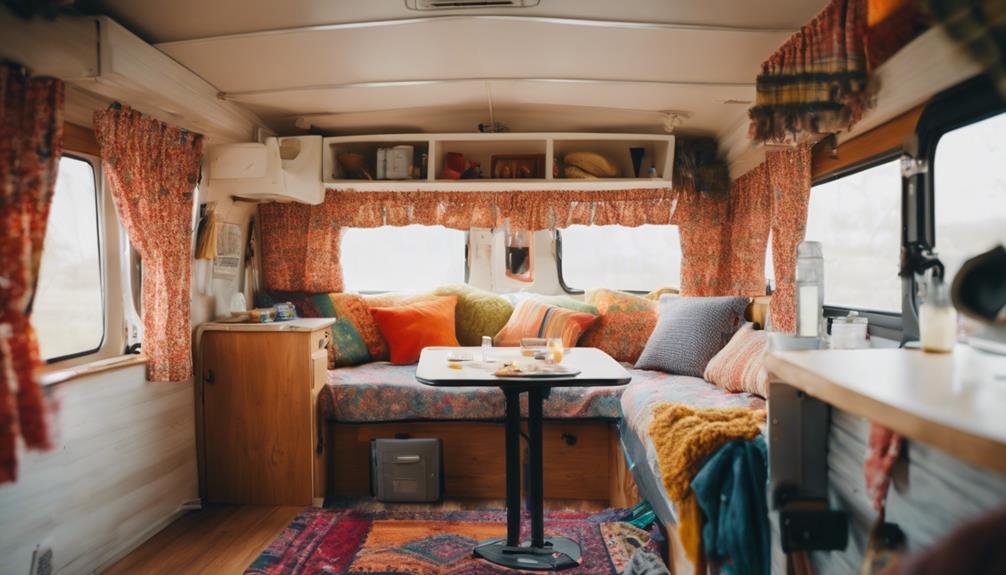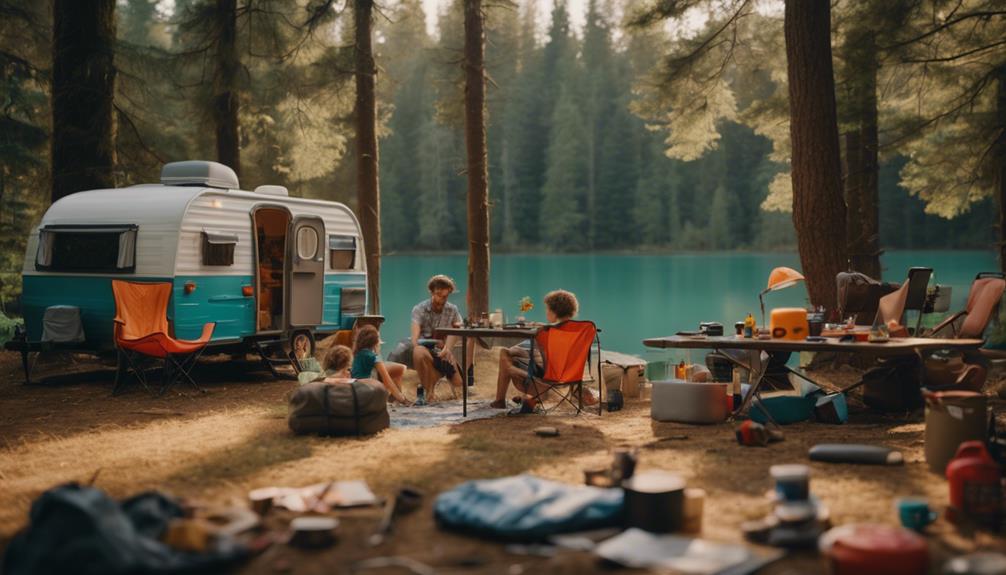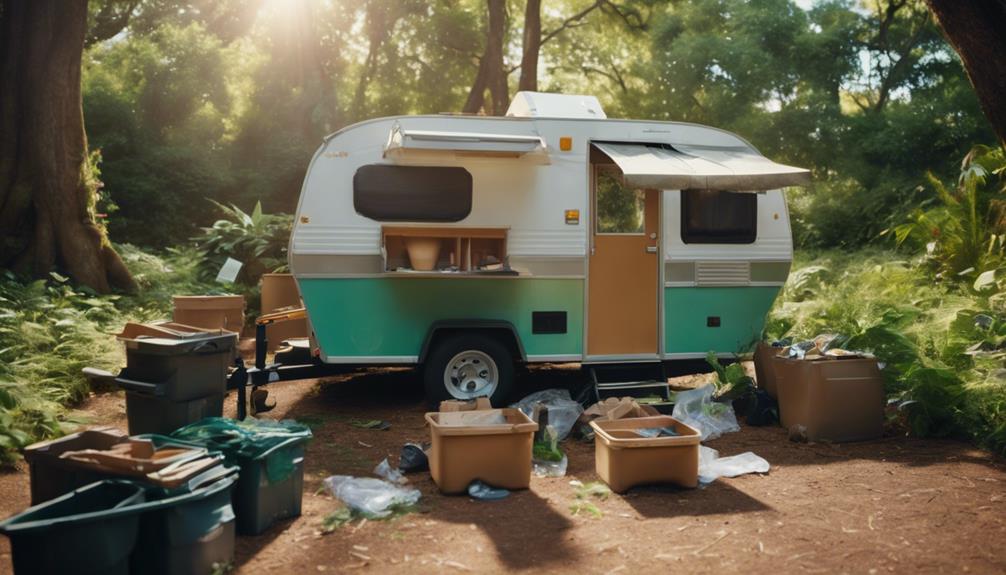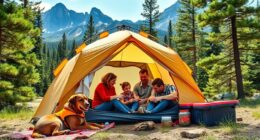Covering your pop-up camper is essential for protecting your investment. Start by choosing a durable cover tailored to your camper's dimensions, ideally made from breathable materials to prevent moisture buildup. Securing the cover tightly with cinching straps and using pool noodles around edges can prevent damage. Regularly check for wear and keep vents clear for proper airflow. During seasonal storage, a well-fitted cover protects against snow and pests. By following these steps, you'll guarantee your camper remains in great condition and ready for your next adventure. There's plenty more to discover about maximizing your camper's lifespan and protection.
Key Takeaways
- Choose a durable, breathable cover that fits your pop-up camper's dimensions to ensure proper protection against moisture and environmental elements.
- Secure the cover tightly using cinching straps and underbelly straps to prevent shifting and enhance ventilation during windy conditions.
- Regularly inspect and clean the cover to remove debris, check for wear, and prevent mold growth for long-lasting protection.
- Implement seasonal storage strategies, such as using a heavy-duty tarp underneath, to shield your camper from snow and moisture during winter.
Choosing the Right Cover
When you're choosing a cover for your pop-up camper, focus on finding a durable option that fits your specific model perfectly. Look for options like the Adco cover, known for its reliability and snug fit.
Start by measuring your camper, which typically ranges from 6 to 8 feet long. Select an RV cover that matches your dimensions—like 102 in (L) x 46 in (W) x 87 in (H)—to guarantee thorough protection.
Breathable covers are essential, as they prevent moisture buildup that can lead to mold or mildew. Materials like spunbond polypropylene and microporous films offer excellent breathability while shielding your camper from harmful UV rays, rain, and snow.
Additionally, consider purchasing from reputable brands that provide warranties and boast high customer satisfaction ratings. This not only assures quality but also gives you peace of mind.
Don't hesitate to utilize customer support services for assistance with size selection and tailored recommendations based on your local climate and storage conditions. Taking these steps will help you choose the right cover, guaranteeing your pop-up camper stays protected and ready for your next adventure.
Understanding Cover Features
Understanding the various features of pop-up camper covers is vital for guaranteeing your camper stays protected and lasts longer. Look for covers made from breathable materials like spunbond polypropylene. These materials help prevent moisture accumulation while guarding against harsh weather conditions such as sun, rain, sleet, and snow.
To enhance stability, many covers include cinching straps at the front and rear, along with an underbelly strap system. These features guarantee a secure fit, minimizing loose fabric that can flutter in the wind. Additionally, covered air vents are essential as they reduce billowing during high winds and promote air circulation, keeping the interior cooler on hot days.
When choosing a cover, prioritize high-quality options that offer a three-layer top construction. This design combines durability with breathability, extending your camper's lifespan. Features like elastic hems and zippered panels further enhance usability, allowing for easy installation and convenient access.
Installation Tips and Techniques
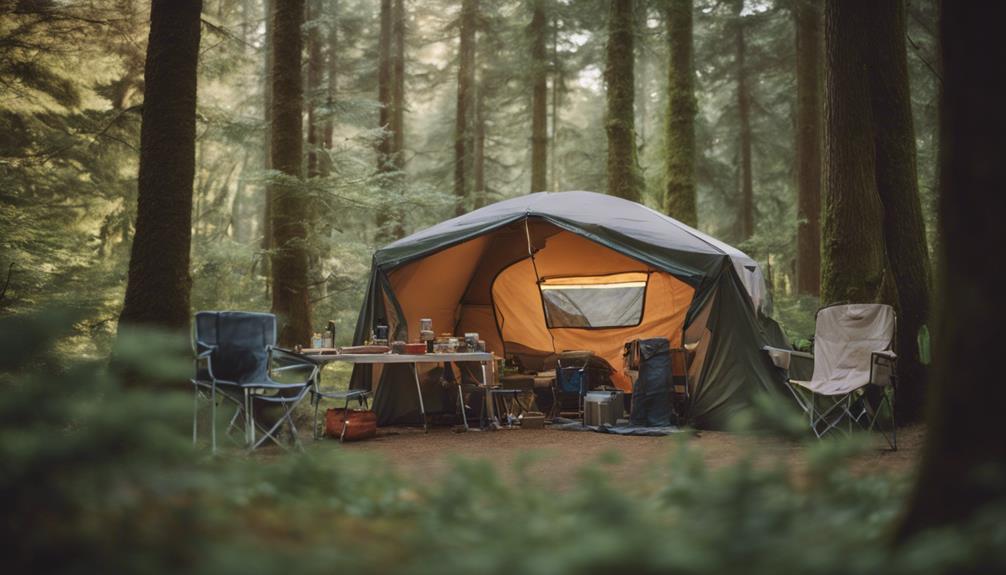
When you're ready to install your pop-up camper cover, you'll want to focus on a few key techniques.
Start with securing the cover tightly to prevent any shifting, and remember to take into account ventilation to avoid moisture buildup.
These steps will help protect your camper and guarantee it stays in great shape.
Covering Techniques Overview
Covering your pop-up camper efficiently requires the right techniques to guarantee protection and longevity. Start by using pool noodles or pipe insulation around the roof edges before placing the cover; this step helps prevent damage during installation.
Once you have the cover in position, make sure it sits just below where the top meets the body of the camper. This positioning is vital for proper ventilation, as it allows for airflow while protecting against the elements.
Utilizing a cover made from breathable fabric is essential, as it helps reduce moisture build-up and prevents mold growth underneath. Look for vent holes in your cover, which facilitate air circulation and enhance protection.
With everything in place, secure the cover tightly using extra straps; this will help prevent movement in windy conditions, keeping your camper's surface safe.
Securing the Cover
To guarantee your pop-up camper cover stays securely in place, use front and rear cinching straps to eliminate any loose fabric and create a snug fit. These straps are essential for securing the cover tightly around your camper, reducing the risk of flapping or shifting.
In addition to the cinching straps, consider implementing an underbelly strap system. This will prevent the cover from blowing off during windy conditions, ensuring your investment remains protected. If you want extra stability, adding additional straps or bungee cords can help keep the cover tightly secured against any wind movement.
Installation typically takes only about 10 minutes, allowing for a quick and efficient setup when you're preparing your camper for storage.
Once the cover is on, don't forget to regularly check its fit and security. Weather changes and wear over time can affect how well the cover stays in place, so it's important to address any issues promptly.
Ventilation Considerations
Securing your pop-up camper cover is just the first step; proper ventilation is vital to preventing moisture buildup and protecting your investment.
Make sure your cover includes ventilation features, like covered air vents, to allow moisture to escape. This helps prevent mold and mildew, which can damage your camper over time.
Choose covers made from breathable materials, such as those with microporous films. These materials promote air circulation while still shielding your camper from the elements, keeping it dry and protected.
When you install the cover, verify it fits snugly around your camper. Use cinching straps to minimize any loose fabric that could billow in high winds. Billowing can compromise the cover's effectiveness and lead to wear over time.
Regularly check the ventilation features during storage. Confirm they're functioning correctly and not blocked by snow, leaves, or debris. This proactive approach enhances airflow around your RV, keeping it cooler in hot weather and extending the longevity of both your camper and its cover.
Maintenance and Care Guidelines
Regular maintenance of your pop-up camper cover is essential for preventing moisture buildup and ensuring long-lasting protection. By following a few simple maintenance practices, you can keep your cover in excellent condition and protect your investment.
- Regularly check and clean your cover to remove debris and prevent mold growth.
- Inspect for wear or damage, addressing any issues quickly to maintain its protective qualities.
- Use breathable covers that allow air circulation, reducing the risk of moisture trapping and protecting internal components from rust.
When you prioritize these maintenance guidelines, you'll enhance the lifespan of your pop-up camper cover and improve the overall condition of your RV.
Make it a habit to routinely inspect and care for your cover, ensuring it remains an effective barrier against the elements. By taking these steps, you'll enjoy peace of mind knowing your camper is well-protected and ready for your next adventure.
Seasonal Storage Considerations
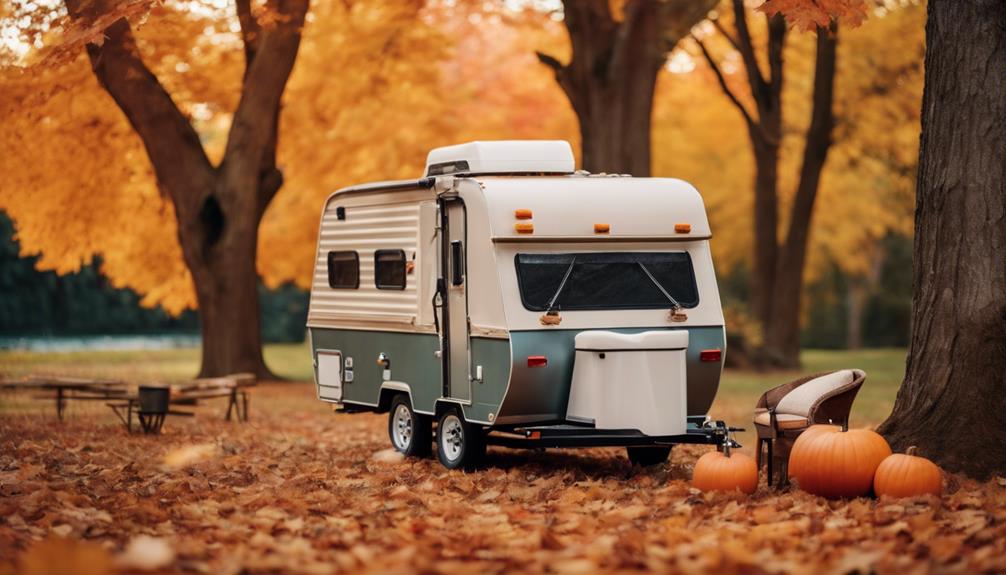
When you're storing your pop-up camper for the winter, it's essential to think about both protection from the elements and preventing unwanted critters.
A breathable cover can keep moisture at bay, while sealing off openings will help deter mice.
Let's explore some effective strategies for winter storage and keeping pests out.
Winter Storage Tips
To keep your pop-up camper in top shape during winter storage, use a breathable cover that allows ventilation while protecting it from snow and ice. This is vital for preventing moisture accumulation, which can lead to mold and damage. Regularly check your cover for snow buildup; removing it promptly helps avoid structural issues.
Here are some winter storage tips to guarantee your camper stays protected:
- Use a heavy-duty tarp underneath your camper for added moisture protection.
- Store your camper indoors or in a carport if possible, shielding it from harsh winter conditions.
- Secure your cover tightly to prevent wind movement, which can cause wear and tear.
Mice Prevention Strategies
Effective mice prevention strategies are vital for keeping your pop-up camper safe during seasonal storage. Start by sealing all potential entry points, especially around vents and gaps. Mice can squeeze through surprisingly small spaces, so be thorough in your inspection.
Next, avoid leaving any food items or attractants inside the camper. Even crumbs can lure rodents and increase your risk of an infestation. Maintaining cleanliness is essential; regularly check for signs of mice and keep the interior tidy to create an unwelcoming environment for pests.
You might also consider using peppermint oil on cotton balls. Placing these strategically inside the camper can effectively deter rodents due to its strong scent they dislike. Traditional deterrents like mothballs can be effective, too, but make sure they're safely placed to prevent accidental ingestion.
Lastly, when you cover your camper, make sure the cover fits snugly. A well-fitted cover can help prevent mice from entering while offering protection against the elements. By implementing these mice prevention strategies, you can enjoy peace of mind knowing your investment is protected during the off-season.
Environmental Protection Strategies
Protecting your pop-up camper from environmental elements requires strategic measures that guarantee its longevity and functionality.
Start by investing in breathable covers. These covers prevent moisture accumulation while shielding your camper from rain, snow, and harmful UV rays. Using brands like Adco or Classic Accessories can be beneficial.
To enhance moisture protection, consider adding a tarp under the cover, particularly if you live in snowy areas. Make sure it's positioned just below the camper's roof for ideal ventilation. Regularly check the integrity of your cover and remove any snow build-up, as it can compromise your camper's structure.
Utilize cinching straps and bungee cords to secure covers tightly against wind movement. This minimizes the risk of the cover rubbing against the camper, which could lead to paint damage.
Don't forget about pest prevention. Seal all openings and use peppermint oil or mothballs inside the camper to deter rodents during storage.
- Use breathable covers
- Incorporate tarps for added moisture protection
- Regularly check cover integrity
User Experiences and Insights
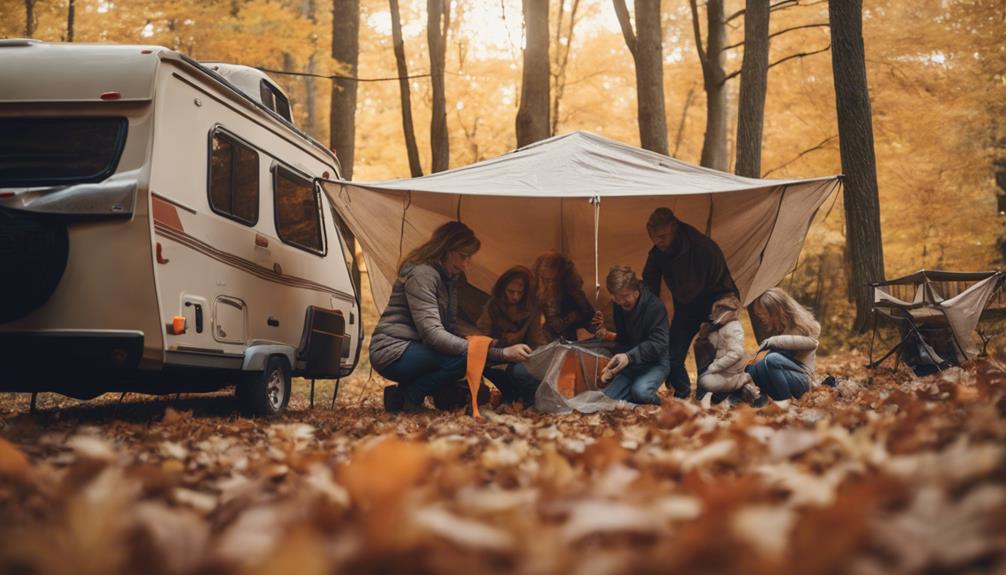
Users often share varied experiences with camper covers, highlighting both their benefits and potential drawbacks. Many appreciate the protection covers offer against environmental elements, especially those using durable brands like Adco.
However, some users express concerns about moisture retention in less breathable options, which can lead to mold and mildew if proper ventilation isn't maintained.
To mitigate these issues, incorporating protective measures is essential. For instance, using pool noodles or pipe insulation along roof edges before covering can prevent damage during storage. Regular inspections of both the covers and the camper are also recommended to catch any signs of wear or moisture buildup early on.
While some find covers indispensable for safeguarding their investment, others prefer indoor storage to avoid cover-related complications entirely. This underscores the importance of evaluating your own storage situation and needs when deciding on a cover.
Ultimately, knowing how to balance protection and ventilation can help you make an informed choice that best suits your camper's longevity and maintenance.
Common Damage Risks
Neglecting proper covering techniques can expose your pop-up camper to various damage risks that could lead to costly repairs. Improper covering not only invites wear and tear but can also result in repair costs exceeding $4,000. To keep your camper in top shape, understanding these common damage risks is essential.
Pest Invasion: Mice can wreak havoc on upholstery and internal components if all openings aren't adequately sealed.
Mold Growth: Failing to clean and maintain your camper regularly can lead to mold development, especially in humid conditions.
Structural Damage: Accumulated snow on your camper can compromise its structural integrity if not monitored and cleared regularly.
Insurance Gaps: Many insurance claims won't cover damages stemming from improper storage and lack of preventative measures, highlighting the need for effective protective measures.
Enhancing Cover Longevity
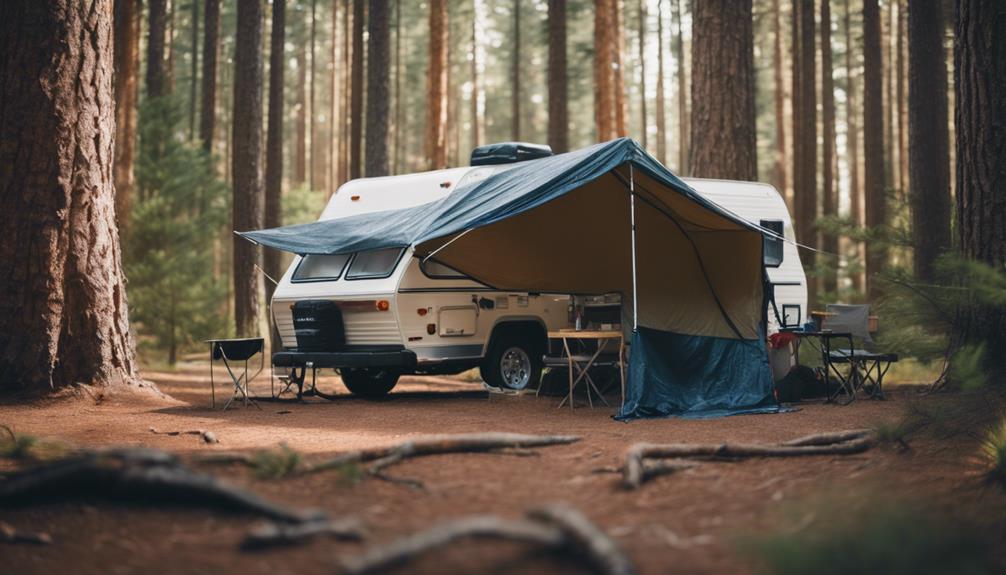
Regularly maintaining your pop-up camper cover can greatly extend its lifespan and effectiveness. Start by inspecting and cleaning the cover often to remove dirt and debris. This prevents wear over time and keeps its protective capabilities intact.
Choose covers made from breathable materials like spunbond polypropylene to prevent moisture build-up, which can lead to mold and mildew. Additionally, guarantee your cover has air vents. These vents allow for proper ventilation, maintaining air circulation and reducing billowing during strong winds.
This helps prevent excessive movement that could wear down the fabric over time. When putting on the cover, make sure to secure the cover tightly using cinching straps and underbelly straps. This minimizes loose fabric that can flap in the wind, reducing the risk of damage to both the cover and your camper.
Frequently Asked Questions
Should You Put a Tarp Over a Pop-Up Camper?
Yes, you should put a tarp over your pop-up camper. It protects against snow and ice, prevents moisture buildup, and keeps your camper in good condition during winter. Just make certain of proper ventilation and secure it tightly.
How Do I Keep My Pop-Up Camper From Being Stolen?
Nearly 400,000 campers are stolen annually in the U.S. To keep yours secure, invest in high-quality locks, use a GPS tracker, park in well-lit areas, and engage with a local RV community for support.
Should I Insure My Pop-Up Camper?
Yes, you should insure your pop-up camper. It protects you from significant financial loss due to theft, damage, or accidents. Consider tailored RV policies for extensive coverage and possible discounts to keep costs manageable.
Should You Cover a Pop-Up Camper in the Winter?
Yes, you should cover your pop-up camper in winter. It protects against snow, ice, and moisture, preventing structural damage and mold. Regularly check and remove snow to avoid excess weight damaging your camper.
Is Locking a Pop-Up Camper Sufficient to Protect it from the Elements?
Locking your pop-up camper is a good start, but it may not fully secure your popup camper belongings from the elements. Consider investing in additional weatherproofing measures, such as tarps or sealants, to provide extra protection against rain, wind, and other environmental factors.
Conclusion
Covering your pop-up camper is like wrapping a cherished gift—you want to protect it for years to come.
By choosing the right cover and following the tips outlined, you not only shield your investment from the elements but also enhance its longevity.
Regular maintenance and being mindful of seasonal storage can help prevent damage.
So, take the time to care for your camper, and it'll reward you with countless adventures ahead.

